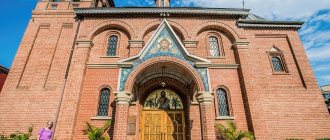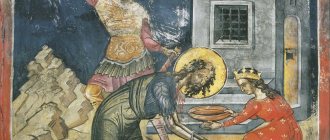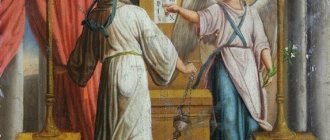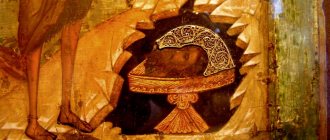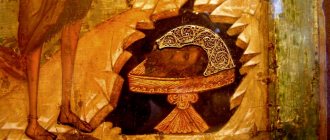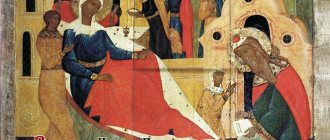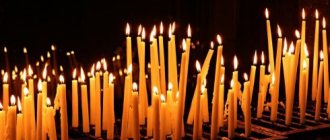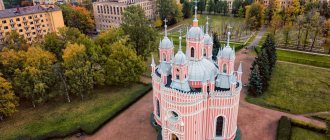| Prophet John the Baptist, icon |
John the Prophet, Forerunner and Baptist of the Lord
(c.), martyr. After the Most Holy Theotokos, the most revered saint. The following holidays were established in his honor: September 23 - conception, June 24 - Nativity, August 29 - beheading, January 7 - Council of John the Baptist in connection with the feast of Epiphany, February 24 - his first and second discovery chapter, May 25 - the third discovery of his head, October 12 - the celebration of the transfer of his right hand from Malta to Gatchina.
The Prophet John the Baptist was the son of the priest Zechariah (from the family of Aaron) and the righteous Elizabeth (from the family of King David). His parents lived near Hebron (in the Highlands), south of Jerusalem. He was a relative of the Lord Jesus Christ on his mother's side and was born six months before the Lord. As Evangelist Luke narrates, the Archangel Gabriel, appearing to his father Zechariah in the temple, announced the birth of his son. And so the pious spouses, deprived of the consolation of having children until old age, finally have a son, whom they asked for in prayers.
By the grace of God, he escaped death among the thousands of murdered infants in and around Bethlehem. Hearing about the murders, Elizabeth took the boy and retired to the desert mountains. Seeing the approaching warriors, she prayed to God for salvation and then the mountain parted, accepted her along with her son and hid her from her pursuers. Not finding them, the warriors inquired about the Forerunner from Zechariah, who was eventually killed. Elizabeth died in the mountains forty days after the murder of her righteous husband, and Saint John was nourished by an angel until he came of age. He grew up in the wild desert, preparing himself for great service by a strict life of fasting and prayer. The Forerunner wore rough clothes secured with a leather belt and ate wild honey and locusts. He remained a desert dweller until the Lord called him at the age of thirty to preach to the Jewish people.
| John the Baptist, icon, XIV century. |
Sermon
Obeying this calling, the prophet John appeared on the banks of the Jordan to prepare the people to receive the expected Messiah (Christ). Before the holiday of purification, people gathered in large numbers to the river for religious ablutions. Here John turned to them, preaching repentance and baptism for the remission of sins. The essence of his preaching was that before receiving external washing, people must be morally cleansed, and thus prepare themselves to receive the Gospel. Of course, John's baptism was not yet the grace-filled sacrament of Christian baptism. Its meaning was spiritual preparation for the future baptism of water and the Holy Spirit.
According to the expression of one church prayer, the Prophet John was a bright morning star, which in its brilliance surpassed the radiance of all other stars and foreshadowed the morning of a blessed day, illuminated by the spiritual Sun of Christ (Mal. 4: 2). When the expectation of the Messiah reached its highest degree, the Savior of the world Himself, the Lord Jesus Christ, came to John to the Jordan to be baptized. The baptism of Christ was accompanied by miraculous phenomena - the descent of the Holy Spirit in the form of a dove and the voice of God the Father from heaven: “This is My beloved Son...”
Having received a revelation about Jesus Christ, the prophet John told the people about Him: “Behold the Lamb of God, who takes away the sins of the world.” Hearing this, two of John's disciples joined Jesus Christ. They were the apostles John the Theologian and Andrew the First-Called, brother of Simon Peter.
With the baptism of the Savior, the prophet John completed and, as it were, sealed his prophetic ministry. He fearlessly and strictly denounced the vices of both ordinary people and the powerful of this world. For this he soon suffered.
Dungeon
King Herod Antipas (the son of King Herod the Great) ordered the prophet John to be put in prison for denouncing him for abandoning his lawful wife, the daughter of the Arabian king Aretha, and for illegally cohabiting with Herodias, who Herodias had previously been married to Herod’s half-brother, Philip.
| The beheading of John the Baptist, icon |
Execution
On his birthday, Herod Antipas gave a feast, which was attended by many noble guests. Salome, the daughter of Herodias, with her immodest dancing during the feast, pleased Herod and the guests reclining with him so much that the king promised with an oath to give her everything she asked for, even up to half of his kingdom. The dancer, taught by her mother, asked to be given the head of John the Baptist on a platter. Herod respected John as a prophet, so he was saddened by such a request. However, he was embarrassed to break the oath he had given and sent a guard to the prison, who cut off John’s head and gave it to the girl, and she took the head to her mother. Herodias, having outraged the cut off holy head of the prophet, threw it into a dirty place. The disciples of John the Baptist buried his body in the Samaritan city of Sebaste.
For his crime, Herod Antipas received retribution in the year after R. X.; his troops were defeated by Arethas, who opposed him for dishonoring his daughter, whom he abandoned for Herodias, and the following year the Roman emperor Caligula exiled Herod to prison.
About the prophet John the Baptist, the Lord Jesus Christ said: “Among those born of women there has not arisen a greater (prophet) than John the Baptist.” John the Baptist is glorified by the Church as “an angel, and an apostle, and a martyr, and a prophet, and a candle-bearer, and a friend of Christ, and a seal of the prophets, and an intercessor of old and new grace, and the most honorable and bright voice of the Word among those born.”
| Life of St. Prophet and Baptist of the Lord John. Icon |
Birth of John
The birth of this saint is so miraculous that it is written about him in the Gospel of Luke . His parents were Saints Zechariah and Elizabeth. Zechariah was a priest who served in the Jerusalem Temple. His wife Elizabeth was a relative of Mary, the Most Holy Theotokos. Therefore, it turns out that Saint John the Baptist was in earthly kinship with the Savior.
Appearance of Archangel Gabriel
Zechariah and Elizabeth did not have children; they were already old. One day, Zechariah, according to custom, served in the temple and walked with incense, and all the people stood outside, as was customary. When he was alone in the temple, he suddenly saw a heavenly phenomenon. Archangel Gabriel appeared before him and announced the good news that his prayer had been heard. That Zechariah will have a son, who will be named John, he will be great before the Lord, and will turn the hearts of many people to God.
To this Zechariah objected: how can this happen when his wife is barren and he is already old. The Archangel answered: “Because you did not believe my words, you will remain mute until this is done . The heavenly phenomenon disappeared, and Zechariah suddenly felt that he had lost his tongue and could not utter a word.
Meeting of Elizabeth and the Virgin Mary
He went out to the people, and the people realized that the priest had been honored with a manifestation from Above. After his ministry, he returned to the house, and his wife soon became pregnant. In the sixth month, as we know from the Gospel , the Mother of God herself came to Elizabeth with the joyful news that she would be the Mother of Christ. It was natural, the Most Pure One wanted to share her joy with her relative, especially since the Archangel told Her that Elizabeth conceived in old age.
But before She could tell her the news, baby John, who was in Elizabeth’s womb, leapt for joy that he felt the presence of the Mother of God with Christ. Because of this, Grace came over Elizabeth, and she herself understood everything and began to praise the Mother of God who came to her.
So, in essence, St. John the Baptist’s acquaintance with Christ occurred even before their birth. When the time came for John to be born , they asked Elizabeth what name to name the baby. She answered: John, to the surprise of many, because they had never heard such names before. Then they asked Zechariah the same thing, he wrote on the tablet: John, the name that the Archangel told him. Then everyone was surprised that the parents were unanimous in choosing the child’s name.
a miracle happened : the father suddenly got rid of his muteness and began to loudly praise God for giving him a son. He also began to prophesy that John would be a great man, a saint of God, a prophet.
Forerunner of the Lord
He was an ascetic, wore clothes made from rough camel skin all year round, and, wearing a leather belt, ate wild honey and locusts. He denounced sinners and called them to repentance. He was the first to see the Son of God in Jesus and announced this to the people. In him, believers saw the incarnation of the prophet Elijah. As you guessed, we will talk about John the Baptist.
The earthly life of John has much in common with the earthly life of Jesus Christ. To begin with, they were distant relatives. John's mother - righteous Elizabeth - was the sister of Saint Anna, the mother of the Most Holy Theotokos. Like Jesus, the Lord God allotted John 30-odd years of earthly life. Like Christ, John called on people to repent of their sins, “for the kingdom of heaven is at hand” (Matthew 3:2).
...John was a true gift from the Lord to his parents - the priest Zechariah and his wife Elizabeth the Righteous. After all, he was born when it seemed to them that they would remain childless until the end of their days.
One day, when the priest Zechariah was serving in the Jerusalem Temple, Archangel Gabriel appeared to him and said that his elderly wife would soon give birth to a son. And his son “will be great before the Lord... And he will go before Him in the spirit and power of Elijah” (Luke 1:15-17). Zechariah heard the words of the Archangel, but did not believe him, and for his unbelief he was punished by muteness...
And when Elizabeth had a son, she, at the inspiration of the Holy Spirit, named him John, although she did not have a single relative in her family with that name. And when the mute Zechariah was asked what he wanted to name his son, he also wrote the name on the tablet: John. And at that very moment I regained the power of speech.
John suffered severe trials as a child. True, he did not fall at the hands of Roman soldiers during the massacre of 14 thousand babies in Bethlehem and the surrounding area: his mother, having heard about King Herod’s order to kill all children under the age of 2, took her son and went with him to the mountains. “And I looked for places to hide it, but I couldn’t find it. And she exclaimed with a loud voice, saying: Mountain of God, let the mother and son in, and the mountain opened and let her in. And the light shone for them, and the Angel of the Lord was with them, protecting them” (Proto-Gospel of James, XXII).
The servants of King Herod, not finding John, broke into the Jerusalem Temple and began to torture the priest Zechariah, trying to find out through him where John was hiding. Zechariah did not tell them anything and, on the orders of Herod, was killed in the temple at the altar... 40 days after his death, his wife, Elizabeth, also died.
...John was left without parents. Perhaps he was raised by relatives - members of the religious stern and ascetic sect of the Essenes. One thing is clear: the Lord kept John for a great mission, destined only for him. Through fasting and prayer, severe asceticism, eating only wild honey and locusts (fruits of the bread, or carob, tree; it was eaten only by the poor and ascetics, it was added to livestock feed - Ed.), John prepared himself for great service.
And finally his time has come. The service that fell to John from the Lord included, so to speak, three components. The first is to expose human sins, calling people to repentance: “And he went throughout all the surrounding country of Jordan, preaching a baptism of repentance for the forgiveness of sins” (Luke 3:3). The second element of the ministry seemed to follow from the first: John baptized repentant sinners, immersing them in the waters of the Jordan River. Washing was a symbol of cleansing from sins: “And the whole country of Judea and the people of Jerusalem came out to him; and they were all baptized by him in the Jordan River, confessing their sins” (Mark 1:5).
And finally, the third - almost the most important - element of John's mission: he was supposed to announce the imminent appearance of the Messiah: “John answered everyone: I baptize you with water, but one stronger than me is coming, whose sandal strap I am not worthy to untie; He will baptize you with the Holy Spirit and fire” (Luke 3:16).
No wonder John was called the Forerunner. He was sent to anticipate the coming of the Savior of the world, to prepare the people for His appearance, just as the first rays of dawn anticipate a sunny morning. It is no coincidence that the Gospel of John says about John the Baptist: “He was not light, but was sent to testify about the Light” (John 1:8).
The significance of John the Baptist is great for the Church and all believers. Indeed, thanks to him, the Sacrament of Baptism arose as a necessary condition for entering the Christian Church. It was John who was the first person who saw the Messiah in Jesus and pointed him out to all the people: “Behold the Lamb of God, who takes away the sin of the world; This is the one of whom I said: A man comes after me, who stood before me, because He was before me; I didn't know Him; but for this purpose he came to baptize in water, so that He might be revealed to Israel” (John 1:29-31). By the way, having heard these words of John, two of his disciples joined Jesus Christ and followed Him. These were the apostles John the Theologian and Andrew, brother of Simon Peter.
Christ himself, speaking about John the Baptist, especially singled him out: “Truly I say to you, among those born of women there has not arisen a greater one than John the Baptist. <…> He is Elijah, who must come” (Matthew 11: 11-14).
John's Baptism became a prototype of Christian Baptism. This is the first and very significant Sacrament in the life of a Christian. It is interesting that in the Greek Gospel texts the word “baptism” literally means “immersion.” But, when the Holy Scriptures were translated into Slavic, Saints Cyril and Methodius chose a different word to define this sacrament - with the root “cross”, thereby filling it with a special meaning and reminding us of the sacrifice on the Cross, which Christ accepted, atonement for the sins of all mankind.
The meaning of the great Sacrament of Baptism is that when a person is immersed in water, he dies to a sinful life and is reborn by the Holy Spirit to eternal life. Through the Sacrament of Baptism, a person takes the first step into life with Christ, becoming a member of the Church.
This is how the Gospel describes the Baptism of the Savior: “Then Jesus comes from Galilee to the Jordan to John to be baptized by him. John restrained Him and said: I need to be baptized by You, and are You coming to me? But Jesus answered him: Leave it now; for thus it is fitting for us to fulfill all righteousness. Then John admits Him. And having been baptized, Jesus immediately came out of the water - and behold, the heavens were opened to Him, and John saw the Spirit of God descending like a dove and descending on Him. And behold a voice from heaven, saying: This is My beloved Son, in whom I am well pleased” (Matthew 3:13-17).
Unfortunately, this was the first and perhaps only meeting between Jesus and John in their earthly lives. John completed his mission, and soon the Lord called him to himself. His death and the events that preceded it are presented in detail both in literature and in painting.
It is known that even after Baptism, John continued to expose the sins of people, calling on them to repent. In particular, he accused one of the rulers of Galilee, Herod Antipas, of violating the commandments of Moses: Antipas took his wife Herodias from his brother Herod Philip and began to cohabit with her in sin. John called on Herod Antipas to repent and return his wife to his brother. For this, Herod ordered the Baptist to be seized and imprisoned.
There he was, when one day Salome, the daughter of Herodias, danced in front of him and his guests on the birthday of Herod Antipas and pleased the ruler so much that Herod promised to fulfill any of her requests as a reward. At the instigation of her mother Herodias, who hated the Baptist, Salome asked for John's head. They say that Herod was saddened by this request, because he respected John as a prophet and philosopher. But he was afraid to break his own oath in front of the guests and sent his squire to prison. He carried out the order of the ruler: he cut off the head of John the Baptist and brought it to Salome on a platter. And she handed the head to her mother...
...It's not easy to be first. This requires special courage and fortitude. And therefore, those who go ahead face difficult trials and a tragic fate.
By the way, the relics of John the Baptist suffered no less trials than the lot of John the Baptist the man. A story about them undoubtedly deserves a separate article. Here we will speak only briefly about the fate of the relics of John the Baptist.
The body of John the Baptist was taken by his disciples: they buried him in the Samaria city of Sebastia near the grave of the holy prophet Elisha. There it was for almost 1000 years until the First Crusade, when, at the behest of the Lord, they were found by the noble Genoese crusader Guglielmo Embriaco. He transported the relics of John the Baptist to his homeland, Genoa, and now they are kept in a special ark made of white stone in the Genoese monastery of St. Lawrence.
A chain of difficult trials, discoveries and mysterious disappearances befell the severed head of John the Baptist. It is known that Herodias, who had a wild hatred for John the living, violated his head: she stabbed it with a dagger, and then buried it somewhere in a “dishonorable place” on the territory of her palace. But the wife of the royal steward, the pious Christian Joanna, spied on Herodias, and then secretly dug up John’s head in the night, placed it in a clay vessel with oil and buried it in a secret place on the Mount of Olives.
Many years later, a vessel with the head of John was found when the pious nobleman Innocent decided to build a church on this part of the Mount of Olives. When they began to dig the ground for the foundation, they came across a vessel with the head of the Baptist.
Since then, the head of John has disappeared and reappeared over the course of a thousand years. It passed from hand to hand, was hidden, transported from place to place. Wherever she visited: in the Syrian city of Emes, Constantinople, in the Turkish city of Comana...
It is believed that as a result, the chapter of John the Baptist was divided into several parts and is now kept in different cities. Most of it is located in the main cathedral of the French town of Amiens in northern France. The relic is a human face, only without the lower jaw, lying on a silver dish and covered with a glass protective cap.
True, Catholics are trying to prove that the head of John the Baptist is in their possession and is kept in Rome in the church of San Silvestro in Capito. And Muslims argue just as ardently that the head of John the Baptist is kept in the Umayyad mosque in Damascus. The Coptic monastery of St. Macarius in Wadi Natrun also claims to own the head of John the Baptist. And finally, it was reported that in August 2010 in Bulgaria, on the island of St. Ivan near Sozopol, during archaeological excavations a box with eight facial bones was found, along the edge of which was the inscription: “Lord, save your servant Thomas. Saint John, June 24." Bulgarian archaeologists and priests claim that these bones are part of the head of John the Baptist.
The right hand of John the Baptist has a separate fate - the same one that John the Baptist placed on the head of Christ when he baptized him in the waters of the Jordan. When the holy Apostle Luke, heading to Antioch, passed through Sebastia, where the body of the Forerunner was buried, he wanted to take his relics with him. But the residents of Sevastia refused to part with them. They only allowed the Evangelist to take with him the right hand of the Baptist. Thus began the long chain of journey of this relic.
Saint Luke, as planned, brought the right hand of the Baptist to Antioch, where it was kept peacefully for a thousand years. After the fall of the city, the relic was first transported to the ancient Greek city of Chalcedon, and later to Constantinople. Probably, many sacred relics would sooner or later have gathered within the walls of the Great City if Constantinople had not been captured by the Ottoman Turks of Sultan Mehmed II in 1453. The Right Hand of the Baptist was hastily transported to the island of Rhodes, but when it fell under Turkish pressure, the shrine found refuge in Malta, where it remained for almost three centuries.
Later, at the end of the 17th century, the Knights of Malta presented the right hand of John to the Russian Emperor Paul I, who by that time had become the Grand Master of the Order of Malta. By order of the emperor, a special golden ark was made for the right hand of the Baptist, and it was kept in the royal family - first in Gatchina, then in St. Petersburg.
When bloody unrest began in Russia in 1917, the sacred relic was hastily taken outside the country: first to Scandinavia, then to Serbia and finally to Montenegro. For almost ten years, from 1941 to 1951, the right hand of John the Baptist was secretly kept in the monastery of St. Basil of Ostrog, until one day Yugoslav security officers came for it. For some time it was believed that the right hand of the Forerunner was missing, but in 1993, Abbot Mark (Kalanya) of Cetinje and Bishop Daniel found it in the State Repository of the Historical Museum of the city of Cetinje.
Since then, the right hand of John the Baptist has been kept in the Cetinje Monastery. The relic is missing two fingers – the middle and little fingers. They have their own story. The little finger was first kept in the Church of the Holy Prophet John the Baptist in the Studium Monastery, but when the Turks captured Constantinople, the little finger ended up in the collection of shrines of the Sultan and is now kept in the Ottoman Museum in Istanbul. The middle finger also traveled a lot: first it was presented as a gift to the Nicaean emperor Theodore I Laskar, then for some time it was in the Serbian Žiča monastery, until it ended up in Rome with Pope Pius II. And he sent him to his hometown of Siena, where the finger of the Baptist is still kept in the Church of St. Mary of Siena.
Persecution
Soon after this, Christ was born. Then King Herod, deceived by the magicians, became very angry and gave the order to kill all male infants under two years of age. Elizabeth had to flee with her son into the desert to save him from death. The Mother of God and Christ were then already in Egypt.
At this time, soldiers came to Zechariah, who was serving in the temple, and began to torture him, where his wife and son were. Because he refused to answer, he was stabbed to death right in the temple. Elizabeth spent the rest of her life with her child in the desert. She may have found a water source and ate wild plants. So he and his son did not die of hunger and thirst.
There is a legend that soldiers found her in the desert, but she prayed and the rock closed her with the baby. When John grew up, Elizabeth died of old age. He was left alone and lived in the desert. Why he did not go to the city and become a priest (after all, he was from a priestly family) is unknown.
The Gospel says that John ate wild honey and locusts in the desert. He wore clothes made of camel hair. This is how he lived until the time came for him to preach about Christ.
Prayers
Troparion of the Conception of the Forerunner, tone 4
She who was first without childbearing, rejoiced,/ behold, thou hast conceived the sun, the lamp of the Lord,/ to enlighten the whole world, which suffers from blindness./ Rejoice, Zechariah, crying out with boldness:/ prophet The Most High exists even to be born.
Kontakion of the Conception of the Forerunner, tone 1
Zechariah the great rejoices brightly / with the all-glorious companion Elizabeth, / worthy of the birth of John the Baptist, / whose Archangel brought the gospel, rejoicing, / and we will honor men with due honor, / / I to the secret place of grace.
Troparion of the Nativity of the Baptist, tone 4
Prophet and Forerunner of the coming of Christ, / it is worthy to praise you, we are perplexed, who honor you with love: / the infertility of the one who gave birth and the voicelessness of the father was resolved / by your glorious and honest Christmas, // and the incarnation of the Son of God is preached to the world.
Kontakion of the Nativity of the Baptist, tone 3
Before the barren day of Christ, He gives birth to the Forerunner,/ and that is the fulfillment of every prophecy:/ Whom the prophets preached,/ laid their hand on Him in the Jordan,// the Word of God was revealed to the prophet k, preacher, together with the Forerunner.
Troparion of the Beheading and the General Forerunner, tone 2
The memory of the righteous with praise, / but the testimony of the Lord, the Forerunner, suffices for you: / you have shown that you are truly more honorable than the prophets, / how even in the streams of baptism you were considered worthy of the Preached One ./ Moreover, having suffered for the truth, rejoicing,/ you preached the good news to those in hell of the revealed God flesh,/ which takes away the sin of the world// and gives us great mercy.
Kontakion of the Beheading, tone 5
The forerunner of the glorious beheading,/ there was a certain Divine vision,/ and the coming of the Savior to those in hell;/ let Herodia weep, having asked for lawless murder:/ for God is not the law neither love the living age, // but the feigned, temporary one.
Troparion of the First and Second Finding of the Head, tone 4
Having risen from the earth, the Forerunner’s head/ emanates rays of incorruptible healing to the faithful,/ from above gathers a multitude of angels,/ and then convenes the human race,// unanimously send glory to Christ God. gu.
Kontakion of the First and Second Finding of the Chapter, tone 6
Prophet of God and Forerunner of grace,/ your head, like the most sacred thorn, found from the earth,/ we always accept healing,// for once again, as before, you preach repentance in the world.
Troparion of the Third Finding of the Chapter, tone 4
Like a Divine treasure hidden in the earth, / Christ has opened your head to us, the prophet and Forerunner. / All slaughter, having come together in this discovery, / Let us sing songs of God’s praises to the Savior, / / salvation saving us from corruption with your prayers.
Kontakion of the Third Finding of the Chapter, tone 6
The luminous and Divine pillar in the world, / the lamp of the sun, the Forerunner, / showing its luminous and Divine head at the end, / sanctifies those who faithfully worship and call: / Christ’s wise Cross God, // save us all.
Troparion of the Transfer of the Right Hand, tone 4
Having risen from the earth, the Forerunner's hand/ emanates rays of incorruptible healing to the faithful,/ from above gathers a multitude of angels,/ and now convenes the human race,// unanimously send glory to Christ God gu.
Kontakion of the Transfer of the Right Hand, tone 6
The brightest of the Sun, the Divine Forerunner, / showing at the end his luminous right hand, / now in the north illuminates our blessed Fatherland with it, / enlightening and sanctifying those who faithfully worship , and those crying to Christ: save us through the prayers of your prophet, O Most High King.
Prayer
[1]
Baptist of Christ, preacher of repentance, do not despise me who repents, but uniting with the heavenly ones, pray to the Master for me, unworthy, sad, weak and sad, in many ways the troubles of the one who has fallen, burdened by the stormy thoughts of my mind. Because I am a den of evil deeds, I have no end to sinful customs, because my mind is nailed down by earthly things. What will I do? We don't know. And to whom shall I resort, that my soul may be saved? Only to you, Saint John, give the same name of grace, for you are before the Lord according to the Mother of God, greater than all who were born, for you were deemed worthy to touch the top of King Christ, who takes away sins Ra, Lamb of God. Pray to him for my sinful soul, so that from now on, in the first ten hours, I will bear a good burden and accept recompense with the last. To her, the Baptist of Christ, the honest Forerunner, the extreme Prophet, the first martyr in grace, the teacher of fasters and hermits, the teacher of purity and the close friend of Christ! I pray to you, I come running to you: do not deny me from your intercession, but raise me up, cast down by many sins. Renew my soul with repentance, as with the second baptism, since you are the ruler of both: with baptism you wash away ancestral sin, and with repentance you cleanse every bad deed. Cleanse me, defiled by my sins, and force me to enter, even if nothing bad enters, into the Kingdom of Heaven. Amen.
Sermon and baptism
At the age of thirty, John went out to the people and began to preach . This age was considered by the Jews to be adulthood, the age of wisdom. He began his sermon with a call to repentance. He was not overly polite, he boldly denounced his sins, calling some “a brood of vipers.” It is clear that many may not like this.
John predicted the coming Last Judgment, the coming of Christ. He said that One must come for him, to whom he is not worthy even to take off his shoes, i.e. perform a slave deed. When they asked him what to do, he answered: be content with what you have and share with the poor.
John baptized the people in the Jordan River . When entering the water, people had to name their sins out loud. John said that he baptizes with water, and Christ will baptize with Fire (i.e., with the Grace of the Holy Spirit).
Baptism of Jesus Christ
When Jesus came to him to be baptized, John recognized Him and refused to baptize Him, saying that He was unworthy. He guessed who was in front of him, but received assurance only after. Christ answered him that this is how the law should be fulfilled. Then John agreed.
The Gospel says that when Jesus entered the river, the Holy Spirit descended on Him in the guise of a white dove. The voice of the Heavenly Father sounded from heaven, confirming that this was the Son of God. So John realized that this was the promised Messiah, Christ.
What do they pray to the Forerunner for?
Before the bright and righteous prophet they pray:
- about admonishing sinners;
- about seeing one’s own sins and their causes;
- about spiritual help (strengthening the spirit);
- about help in beekeeping;
- about soil fertility and abundant harvests;
- about getting rid of headaches;
- about healing all kinds of ailments;
- about cleansing thoughts from temptations.
More about Orthodox prayer:
- Prayer before starting a task
- Prayers before and after eating food
- Prayers for the future
Imprisonment and death of John the Baptist
John was not afraid to expose King Herod himself, who lived illegally with his brother’s wife. Who left his wife and took Herodias . She hated John for his denunciation and forced Herod to put the saint in prison, which he did. But the king respected John, came and listened to his words. He did not want to kill him, as Herodias demanded.
One day, on the king’s birthday, there was a feast at which Herod’s niece (Herodias’ daughter from her first marriage) danced. Her name was Salome. The king liked her dance, and he vowed to do whatever she asked for it. Salome did not know what to ask, and went to her mother. She told her to ask for the head of St. John .
When Salome told him her request, the king was upset. After all, he loved John, considered him a saint and did not want his death. But, since he publicly promised to fulfill any wish of Salome, he had to give the order to behead John. When the insidious woman received her victim on a platter, she mocked the head of the saint for some time, piercing his tongue with needles. According to legend, even the death's head continued to accuse Herodias of adultery.
Then she threw her head away. John's body was buried by his disciples in Sebaste . The murderers were severely punished. The father of Herod's abandoned wife went to war against him in order to take revenge and defeated his troops. Herod himself was imprisoned by the Roman emperor. Herodias died a cruel death, falling through the ice, and her head was cut off by ice floes.
The meaning of the icons
John is often depicted with something like a cup or tray, and in it, if we look closely, the child Christ is depicted lying naked. John points to the child.
This will be a mystery if you do not know that such icons mix images from the Bible with images of the Orthodox liturgy.
Consider the scroll that John is holding. It may contain the following words:
Repent, for the Kingdom of Heaven is at hand.
In icons of John depicting a tree, we usually see, if we look closely, that an ax is pierced into its trunk. This image comes from Luke 3:9:
Already the ax lies at the root of the trees, and every tree that does not bear good fruit will be cut down and thrown into the fire.
John's scroll usually reads:
I saw and testified of him: “Behold the Lamb of God who takes away the sins of the world.”
This is a quote from John 1:29:
The next day John sees Jesus coming to him and says: Behold the Lamb of God, who takes away the sin of the world.
Sometimes on the same scroll you can find the inscription: “Repent, for the kingdom of heaven.”
Now let's return to the question of why John holds a cup (sometimes depicted as a tray) with the baby Jesus in it. This is an image from the Orthodox liturgy, in which part of the Eucharistic bread is called “Lamb.” The bread in the liturgy is Christ.
Thus, what John holds, whether it appears to be a cup or a tray, is the “dish” in the liturgy that holds the bread, and the bread is the Body of Christ. In an icon, all these elements are mixed together in one picture.
In some icons, lines can be seen curving up and into the cup held by the Baptist, meeting in a small star at the top.
This liturgical instrument is called the Zvezditsa - an item of church utensils, which consists of two metal cross-shaped arcs connected. Symbolizes the Star of Bethlehem. Its purpose is to support the fabric curtain that is put on the paten.
Some icons of John have background scenes showing events from his life, recounted both in the New Testament and in apocryphal sources, for example, an angel leading the child John into the desert, etc. We see such scenes in this icon:
At top left, an angel leads baby John into the desert. Bottom left is the birth of John the Baptist. At the bottom right is the beheading of John, and at the top right is the discovery of his head.
An unusual feature of this icon is that instead of carrying the infant Christ in a chalice, John here carries his head. The head in a bowl instead of Jesus was and remains the preferred form in Greek iconography, as well as the standard form in Russian iconography until the 17th century, when a “child” in a bowl began to replace it.
When John's head is in the vessel, it tends to emphasize the Death of John as a sort of "precursor" to the death of Jesus, and of course, as mentioned, the "child" in the cup has a Eucharistic meaning.
In some icons, everything except the central picture is covered with decorative metal. Such decoration was common on very old icons. The metal was nailed directly to the surface. This is why old icons, when these covers are removed, remain full of small holes. The metal plating was added as a sign of respect.
Reverence
The holy head of the saint was hidden on the Mount of Olives by one pious woman. Then one person found it, kept it with him and hid it from desecration. Later, John appeared to two monks and showed them the burial place of his head. This is how the holiday of finding the head of the saint appeared.
The right hand of John the Baptist was passed from city to city for a long time, eventually ending up in the Church of the Savior in St. Petersburg.
Saint's Memorial Days:
- July 7 (Nativity of John the Baptist);
- September 11 (Beheading of John the Baptist);
- June 7 (finding of the head of John the Baptist).
Life of John the Baptist (Forerunner)
The story of the right hand of John the Baptist
The fate of John's right hand is interesting. Over the years, she stayed in many countries and blessed the Russian land for more than a hundred years. This fact serves as evidence of the inviolability of the Orthodox faith.
The Apostle Luke, who came to Sebaste with a sermon, asked permission to rebury the headless body of John in Antioch. But the Sebastians did not want to part with the imperishable shrine and allowed the apostle to take only the right hand of the prophet. It was with this that he baptized the Savior. The Right Hand stayed in Antioch for more than 9 centuries, and here the first miraculous gifts were manifested from her.
When Julian the Apostate wanted to burn the shrine, Christians hid it, and the emperor himself was soon killed by Persian soldiers.
Since 1453, the right hand was kept in the treasury of Khan Mohammed, but his son gave the shrine to the Rhodes knights, who moved it to Malta. But at the end of the 18th century, the Maltese saved the right hand from Napoleonic troops and moved it to Gatchina in Russia. Here a special ark was made for the shrine, decorated with gold and precious stones.
During the period of revolutionary persecution of the Church, the right hand was hidden from the destroyers in Estonia, and then transported to Denmark. Later she visited Germany, Serbia, and since 1978 she has been in the Cetinje Mother of God Monastery in Montenegro .
Hand of John the Baptist

